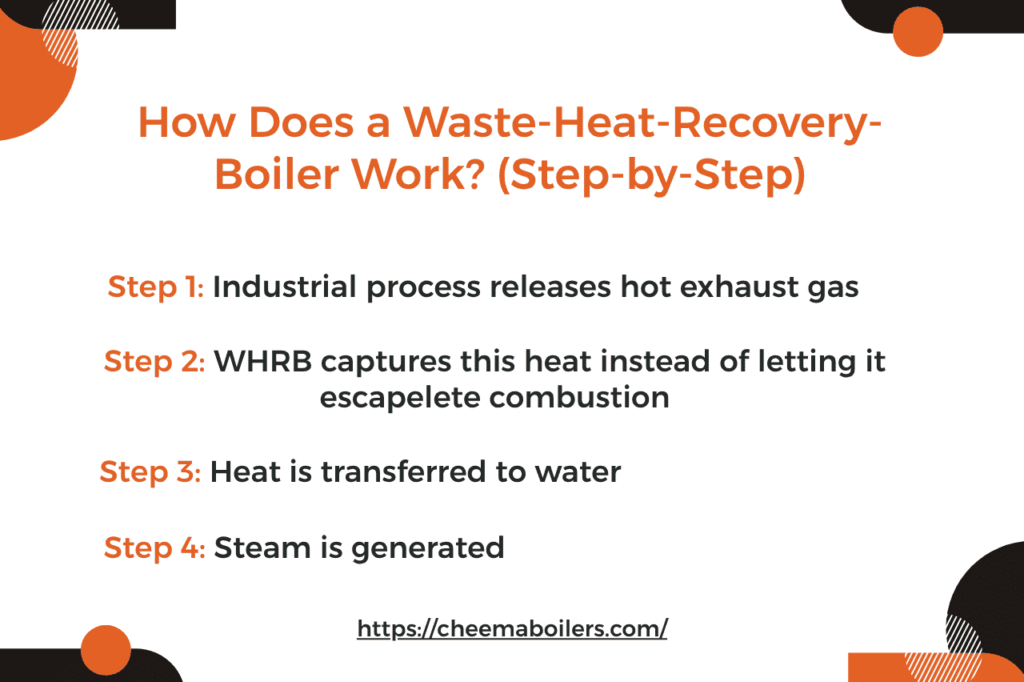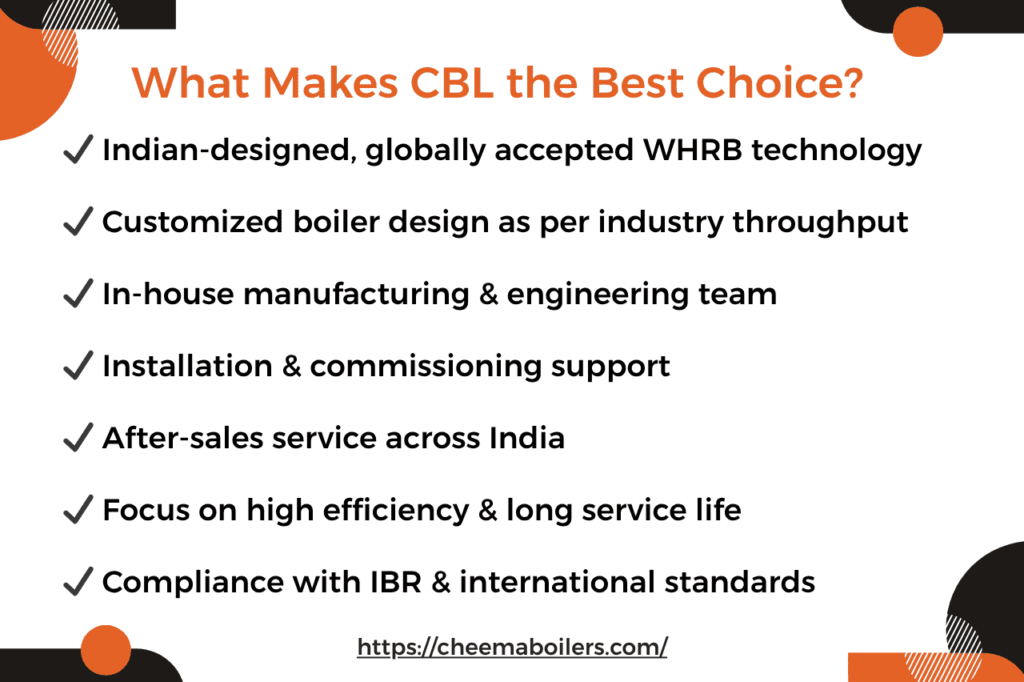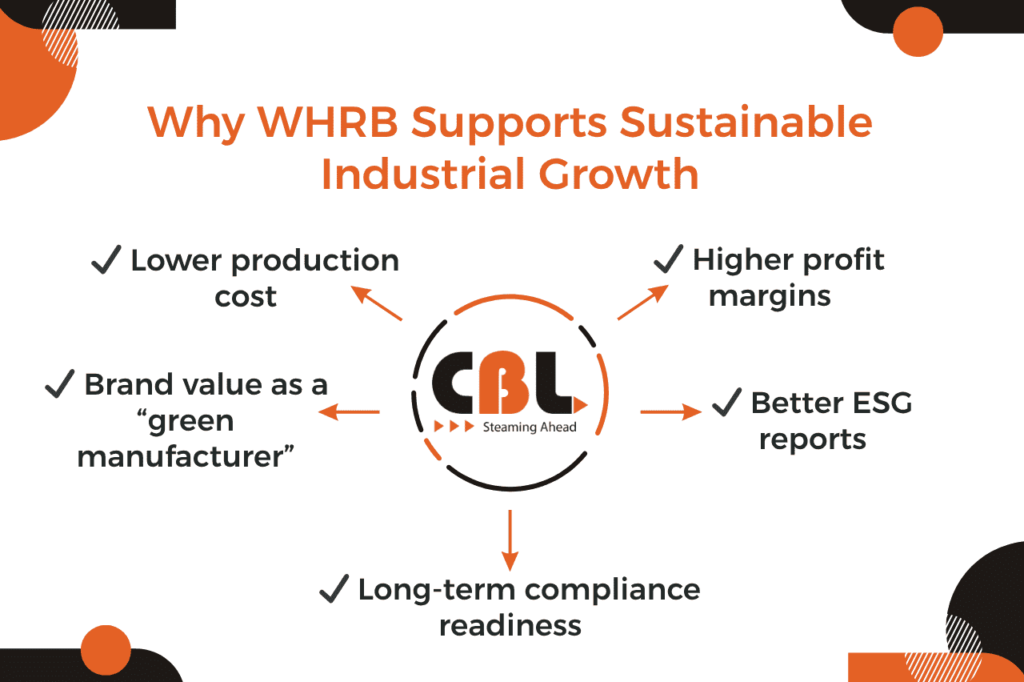Industrial plants across India are under increasing pressure to reduce fuel consumption, cut emissions, and move toward renewable and efficient energy solutions. In this transition, one technology has proven to be a game-changer:
⭐ Waste Heat Recovery Boiler (WHRB)
A waste-heat-recovery-boiler (WHRB) captures heat that would normally escape from industrial processes and converts it into useful steam or power — reducing fuel cost, enhancing plant efficiency, and supporting India’s sustainability goals.
With rising energy prices and strict government compliance requirements, industries are now actively searching for the best waste heat recovery boilers that deliver measurable results.
Among the leading manufacturers stands Cheema Boilers Limited (CBL), headquartered in Mohali, Punjab — a trusted Indian boiler brand providing WHRB solutions for cement, steel, power, chemical, and process industries.
What is a Waste-Heat-Recovery-Boiler?
A waste-heat-recovery-boiler is a specially designed industrial boiler that uses wasted heat energy from industrial operations instead of burning additional fuel.
This unused heat is commonly released from:
Furnace flue gases
Cement kiln exhaust
Gas engine exhaust
Steel reheating furnaces
Chemical reaction outlets
Gas turbine flue gas
Biomass or oil-fired systems
Instead of letting this heat escape through chimneys, WHRB technology traps it and converts it into steam or electricity — creating a secondary source of energy at no extra fuel cost.
Why Industries Need Waste Heat Recovery TODAY
Industries in India face challenges related to:
❗ Rising fuel cost (coal, gas, oil, diesel)
❗ High electricity bills
❗ Mandatory emission control regulations
❗ Sustainability reporting requirements (ESG, ISO, CSR)
❗ Competitive global market prices for exports
In this scenario, a waste-heat-recovery-boiler offers a guaranteed and proven solution:
📉 Reduces plant operating cost
📈 Increases energy efficiency
🌍 Supports carbon neutrality and green energy goals
♻ Uses existing heat — no new energy source required
No wonder WHRBs are now installed in:
✔ Cement plants
✔ Steel rolling mills
✔ Sponge iron industries
✔ Glass factories
✔ Refineries
✔ Chemical plants
✔ Gas engine power plants
✔ Fertilizer industries
✔ Textile processing units
How Does a Waste-Heat-Recovery-Boiler Work? (Step-by-Step)

Here’s a simple explanation:
Step 1: Industrial process releases hot exhaust gas
Example: A cement kiln releases exhaust gases at 300°C–400°C.
Step 2: WHRB captures this heat instead of letting it escape
The system is placed directly in the flue gas line.
Step 3: Heat is transferred to water
Water inside evaporator tubes absorbs heat.
Step 4: Steam is generated
The boiler produces steam without burning fuel.
Step 5: Steam is used for:
✔ Power generation through a turbine
✔ Heating processes
✔ Running captive power plants
✔ Driving turbines for industry operations
Result:
✔ No fuel used
✔ Zero added emissions
✔ High savings
Types of Waste Heat Recovery Boilers
Waste-heat-recovery-boilers come in multiple designs:
Fire Tube WHRB
Hot gas passes through tubes, surrounded by water.
Water Tube WHRB
Water flows inside the tubes, gas surrounds them — most efficient and widely used for high-pressure steam.
Heat Recovery Steam Generator (HRSG)
Used with gas turbines and engines.
Composite Waste Heat Boilers
Designed for dual heat sources.
Hybrid WHRB
Combines heat recovery + small auxiliary burner for backup.
Cheema Boilers manufactures customized WHRBs depending on:
✔ Process gas temperature
✔ Pressure requirement
✔ Steam capacity
✔ Industry application
Key Benefits of Waste Heat Recovery Boiler
Saves Fuel Cost
Up to 30–60% reduction in fuel use depending on plant setup.
Reduces Electricity Bills
Steam converts into captive electricity — saving crores every year.
Improves Efficiency
Plant overall thermal efficiency increases up to 90%.
Cuts Carbon Emissions
No additional combustion = significant emission reduction.
Supports ESG & Net-Zero Goals
WHRB installations qualify for CDM credits & sustainability KPIs.
Less Reliance on Grid Power
Power self-generation protects against power cuts & tariff hikes.
Faster ROI
Investments are recovered in 1.5 to 3 years through fuel savings.
Waste Heat Recovery Boiler Efficiency
Efficiency depends on:
🔹 Gas inlet temperature
🔹 Pressure & steam demand
🔹 Boiler design & tube layout
🔹 Feedwater temperature
🔹 Dust & particulate load
A well-engineered WHRB from Cheema Boilers can achieve:
⭐ 70–85% heat recovery efficiency
This efficiency translates into real industrial savings.
Why Cheema Boilers (CBL) Is India’s Trusted WHRB Manufacturer

Cheema Boilers, Mohali, is one of India’s top industrial boiler companies with three decades of experience and 5000+ successful installations.
What Makes CBL the Best Choice?
✔ Indian-designed, globally accepted WHRB technology
✔ Customized boiler design as per industry throughput
✔ In-house manufacturing & engineering team
✔ Installation & commissioning support
✔ After-sales service across India
✔ Focus on high efficiency & long service life
✔ Compliance with IBR & international standards
Industries Served:
🏭 Cement plants
🏭 Steel & sponge iron plants
🏭 Chemical & fertilizer units
🏭 Food processing & distilleries
🏭 Refineries
🏭 Power generation units
Waste Heat Recovery Boiler Price in India
WHRB pricing depends on:
1️⃣ Boiler capacity (TPH – tons per hour)
2️⃣ Temperature of input gas
3️⃣ Pressure & steam requirements
4️⃣ Dust load & gas composition
5️⃣ Material grade and design
6️⃣ Accessories (economizer, superheater, ESP, stack etc.)
Average Cost Range in India (Approx.):
| Capacity | Approx. Cost (INR) |
|---|---|
| 2 TPH | ₹20–25 Lakhs |
| 5 TPH | ₹45–60 Lakhs |
| 10 TPH | ₹1.5–2.5 Crore |
| 20+ TPH | Custom pricing |
CBL Advantage:
Cheema Boilers provides complete turnkey WHRB projects including:
✔ Engineering
✔ Fabrication
✔ Installation
✔ Performance guarantee
Applications of Waste Heat Recovery Boiler
WHRBs are used in:
🔥 Cement Kilns – Clinker cooler exhaust
🔥 Sponge Iron Plants – Rotary kiln gas
🔥 Steel Rolling Mills – Furnace flue gas
🔥 Glass Factories – Melting furnace heat
🔥 Diesel/Gas Engines – Exhaust heat
🔥 Petrochemical Plants – Reaction heat
🔥 Biomass & Incineration plants
WHRB technology can be installed:
✔ In new plants (Greenfield)
✔ Inside existing facility (Retrofit upgrade)
Future Scope of WHRB in India
India is moving towards:
➡ Net-Zero 2070 Mission
➡ Green hydrogen manufacturing
➡ Energy-efficient industrial expansion
➡ Renewable energy adoption
Government mandates and carbon taxes will push industries to recover heat instead of wasting it.
WHRB will soon become a standard requirement, not just an energy-saving option.
Why WHRB Supports Sustainable Industrial Growth

Industries using WHRB gain direct competitive advantages:
✔ Lower production cost
✔ Higher profit margins
✔ Better ESG reports
✔ Brand value as a “green manufacturer”
✔ Long-term compliance readiness
So, WHRB is not just a boiler…
It is a strategic business asset.
Conclusion
A waste-heat-recovery-boiler is no longer optional — it is essential for industries that want to reduce energy cost, improve efficiency, and move toward carbon-neutral operation.
From fuel savings to emission reduction, from power generation to operational efficiency — WHRB technology delivers immediate and long-term benefits.
With Cheema Boilers Mohali, industries get world-class WHRB solutions designed for Indian conditions, backed by decades of engineering experience and proven performance.
If your plant releases high-temperature exhaust, you are losing money every minute.
Recover that heat. Convert it into power. Cut your operating cost permanently.
* Want to Install WHRB?*
📍 Company: Cheema Boilers Limited
🏭 Location: Mohali, Punjab, India
🔧 Expertise: Industrial Boilers, WHRB, HRSG, Biomass, EPC Projects
Increase efficiency. Reduce cost. Go green.
Your next boiler should not burn fuel —
👉 It should reuse the energy you already have.

